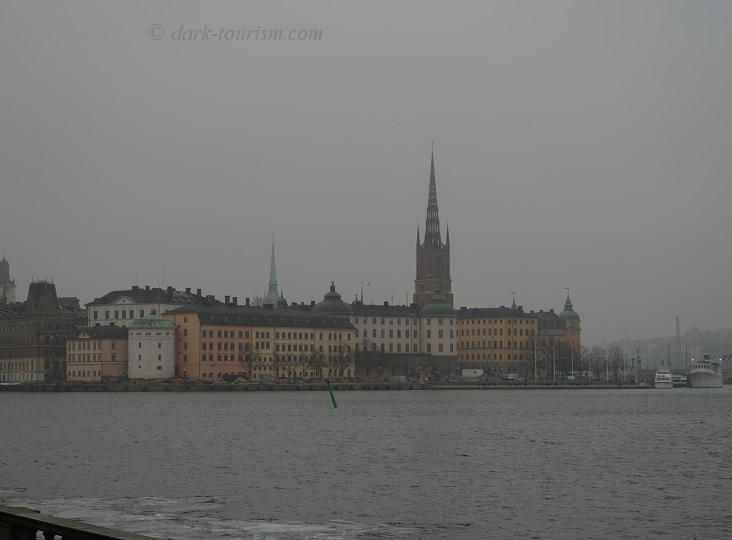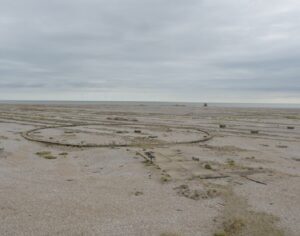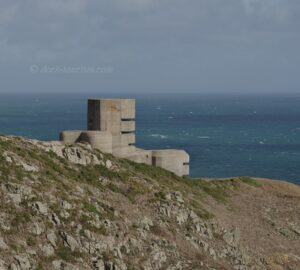Last weekend I was in Sweden’s capital city, tagging on to a group of friends and colleagues of my wife’s, most of whom were primarily interested in sauna-ing and cold-water swimming as well as some mainstream sightseeing. I instead used the Saturday for doing my own thing – and filling a few DT-related gaps. I had been to Stockholm once before, but that was nearly 20 years ago, long before I started dark-tourism.com (or had even heard of the term ‘dark tourism’). In the meantime, I had done my homework and found out about a number of places within the city that are of some DT-relevance. So I tried to tick off as many as I could in the single day I had at my disposal.
I began with a rather more “exotic” site pictured in this photo, Alfred Nobel’s blasting bunkers:

These blasting bunkers were part of the Alfred Nobel factory complex producing the high-explosive nitroglycerine. Apparently the bunkers were used for test detonations. Since most are open on both sides you could also call them ‘blast tunnels’:

And here’s a photo of some of the former factory buildings where the explosives were produced – today these buildings are home to a restaurant/event centre:

Alfred Nobel had begun experimenting with nitroglycerine as well as detonators (to set off explosions remotely by fuse) in the 1850s and early 1860s. However, nitroglycerine is a highly volatile substance and can easily be set off spontaneously by accident (or for apparently no reason at all). Alfred Nobel learned this in practice the hard way when in 1864 his brother Emil was killed in such an accidental explosion. After that Alfred in 1865 acquired the site at Vinterviken as a safe location for his factory in a secluded bay surrounded by hills. Still, deadly accidents continued to occur. However, Alfred Nobel’s experiments to make handling nitroglycerine safer led to him mixing the substance with diatomaceous earth (a kind of clay-like sediment), which stabilized the explosive and made it pliable and safely portable without any loss of explosive power. This was the invention of dynamite, of course, which Nobel then had patented in 1867.
Demand for dynamite skyrocketed in the following years and that made Alfred Nobel incredibly rich. In his will he donated most of his fortune for the creation of the Nobel Prizes (apparently in order to leave behind a better legacy than that of being the inventor of deadly explosives). He passed away in 1896 and the first Nobel Prize was awarded in 1901. Several of the Nobel Prizes are selected annually by the Swedish Academy (a notable exception is the Nobel Prize for Peace, which is selected and presented by the Norwegian Nobel Committee in Oslo). Here’s a photo of the Swedish Academy’s seat in the Old Town of Stockholm, also home to the Nobel Prize Museum:
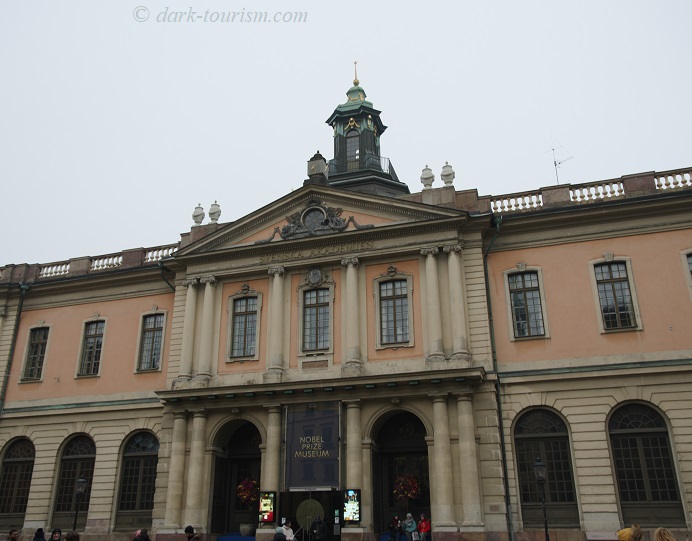
As I had been to this museum before, and because it generally has only vaguely dark associations, I did not bother visiting it this time.
The lavish banquets that follow the Nobel Prize Award Ceremonies are held at the City Hall of Stockholm, the Stadshuset, pictured below:
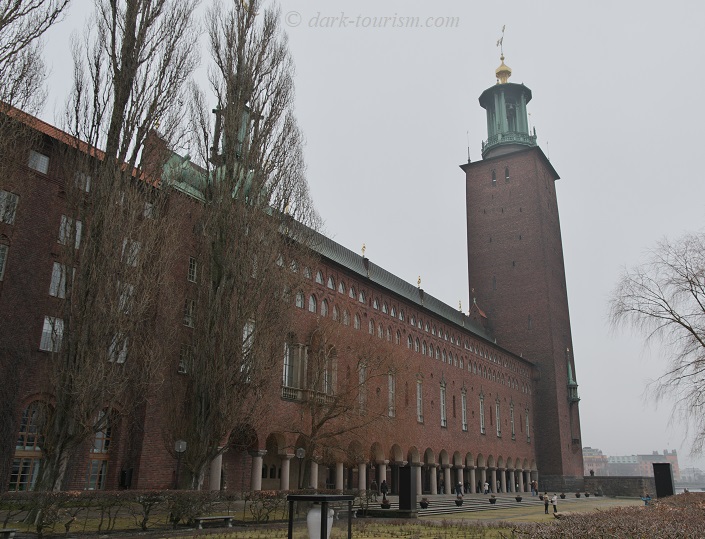
I had intended to climb the tower again for the grand views of the Gamla Stan, or Old Town, of Stockholm from the viewing platform at the top. But I thought better of it as it was so hazy that I would probably have seen less from the tower’s top than what I was able to see from the shore at ground level (same photo as the featured one at the top of this post):

What I also didn’t do was visit the Jewish Museum in the Old Town – as by the time I got there it was about to close, so I had to give it a miss on this occasion. Here’s a photo of the outside, though:

The museum exhibition is said to be mostly about Jewish life in Sweden, but apparently it also has a small section about the Holocaust as well as Raoul Wallenberg (see below).
Another museum that I did visit earlier on this trip, on the other hand, was the Army Museum. Here’s a photo of the exterior:
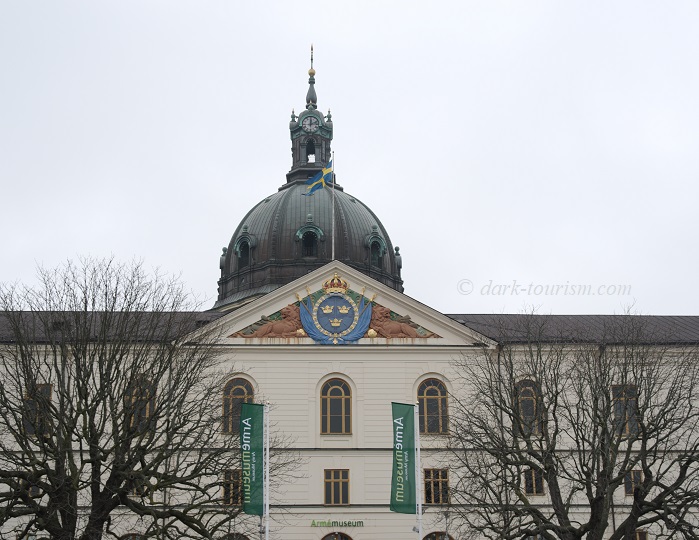
I had read about this museum and hence knew that I would be skipping large parts of it, namely all those earlier historical sections with lots of pre-20th century period uniforms, swords, helmets and whatnot on display. Indeed I raced through all those parts. But the first room, by way of introduction to the topic of war, had an intriguing juxtaposition of exhibits, from prehistory to very recent. One exhibit was a group of stuffed chimpanzees in mid-fight. It’s from chimps that we humans apparently inherited our tendency for aggression and war (chimps are amongst a very small number of species other than humans that do indeed “go to war”, namely against other groups of chimps, in an organized fashion), the other exhibit in this room is this warhead from a Cold-War-era Soviet nuclear missile:
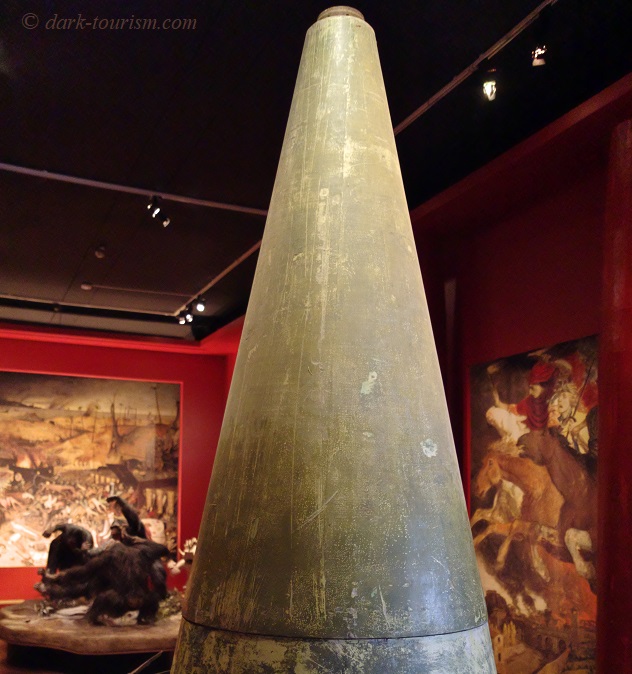
This warhead (deactivated, obviously) was taken from a decommissioned R-12 missile (NATO code name SS-4) from a silo in Estonia (presumably from a missile base equivalent to the one at Plokstine in Lithuania) after 1990.
While Sweden was very much involved in the Cold War, the country has not been actually at war for some 200 years. During WWII it managed to remain neutral (unlike its neighbours), yet the threat from Nazi Germany was there, as the German invasions of Denmark and Norway proved, though those two countries were of greater strategic importance, geographically speaking. Still the museum also has a few displays of German Nazi-era items, such as in this display, which includes a specimen of the legendary Enigma machines:
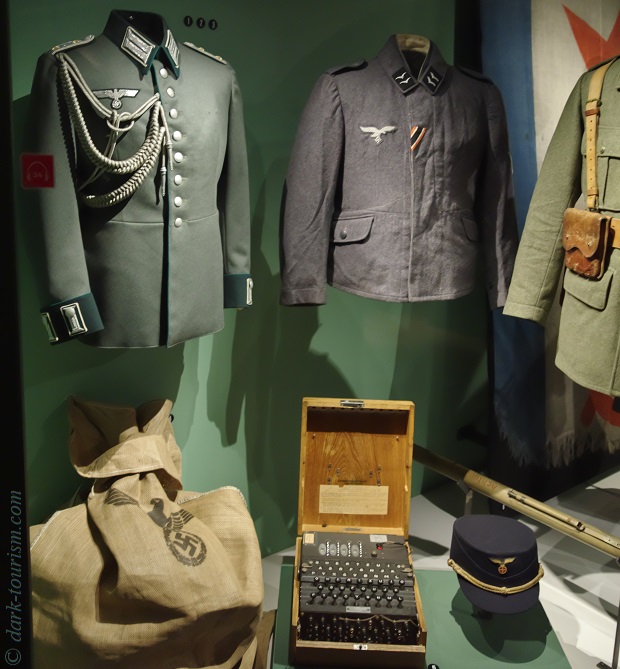
In the decades after WWII and during the Cold War, Sweden remained non-aligned and neutral – until, that is, Sweden joined NATO in 2024 (the pen with which the then Minister for Foreign Affairs signed the application for joining NATO in May 2022, in the wake of the invasion of Ukraine by Russia, is on display at the museum too!). But nevertheless the country developed a sizeable military strength, with domestically produced military hardware, some of which was also lucratively exported to other countries (e.g. Saab “Draken” fighter jets were acquired by Austria, and one of these planes is now on display at the Military History Museum here in Vienna). Here’s a photo of a Swedish-made reconnaissance drone on display at Stockholm’s Army Museum:
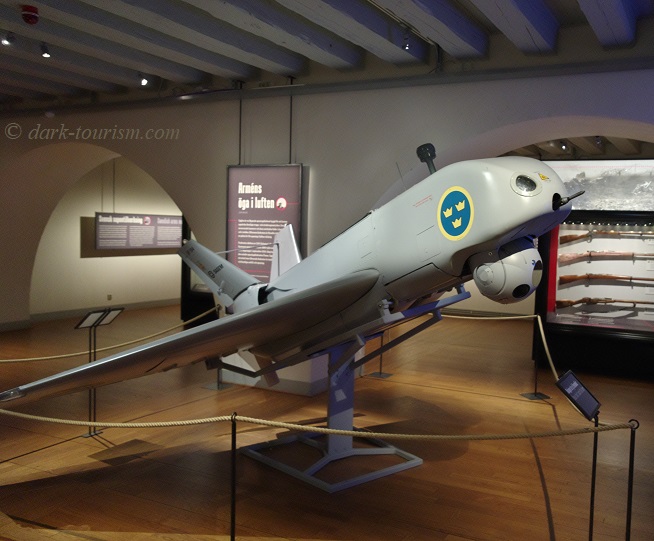
Sweden was only indirectly involved in WWII, but various Swedish individuals played significant roles, including Raoul Wallenberg, who is given a small separate section of his own at the museum:

Wallenberg was a Swedish diplomat in Budapest, Hungary, during WWII and when in 1944 the Holocaust reached that city, he saved countless Jews from deportation to Auschwitz by providing them with Swedish protection papers or issuing false IDs. He risked his own life by doing that, of course. In the end though it wasn’t the Germans but the Soviets who captured Wallenberg and abducted him to Moscow, where he died at the infamous Lubyanka headquarters of the KGB, under still unclear circumstances. He was posthumously awarded the title of “Righteous Among the Nations” by Israel (see Yad Vashem).
Raoul Wallenberg is also honoured by this modest memorial monument outside the Ministry for Foreign Affairs building:
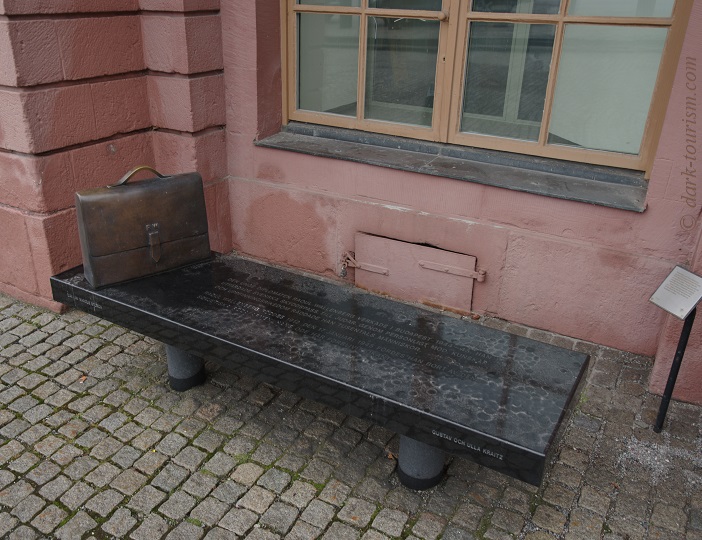
Also in the open air is a plaque marking the spot where Swedish Prime Minister Olof Palme was murdered in the open street by a gunman in 1986 (for reasons that have never been properly established):
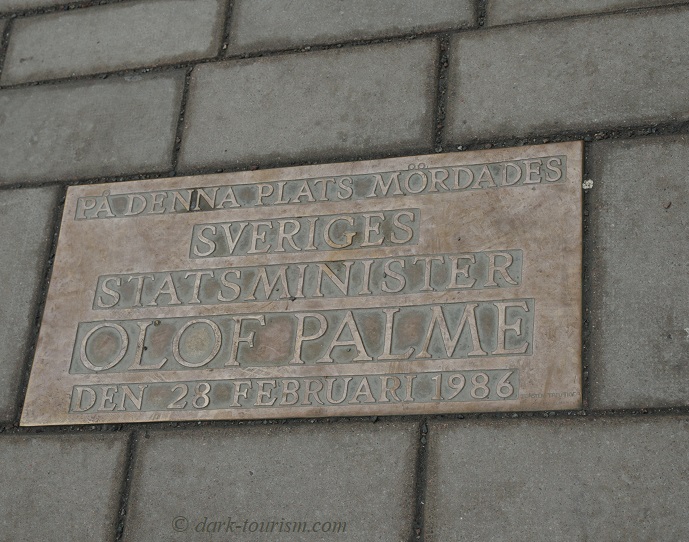
Not marked, on the other hand, is another dark historical spot in the Swedish capital, namely the location of the bank robbery and hostage-taking in 1973 that gave the world the expression “Stockholm syndrome”, after the hostages developed feelings of solidarity with their captor. The bank is long since gone and you have to know what you’re looking at as no plaque or sign explains the historic significance of this corner in Stockholm:

A contemporary dark aspect are terrorist threats in many places in the world, and Sweden is no exception. A recent trend in which vehicles (lorries or cars) are used as the weapon of choice have led to concrete bollards being placed at the access points to pedestrianized streets to prevent vehicle access. These have become a common sight in many cities. In Stockholm I found numerous such concrete security bollards in the shape of lions! Here’s a photo of one such spot:

A dark aspect of a very different kind is behind another sort of object placed on/in the pavement – here it’s a WWF (World Wildlife Fund) “star” with a (fake) footprint, in the fashion of the Walk of Fame in Hollywood, Los Angeles, except it’s for an animal, namely the mountain gorilla:
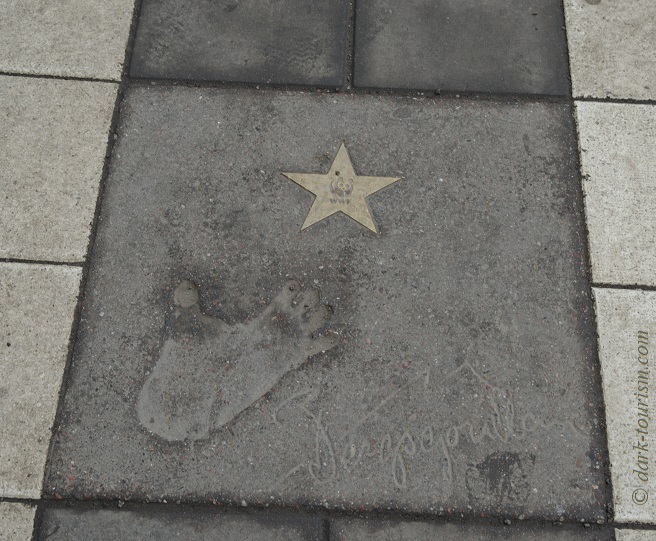
The dark association here is of course that mountain gorillas are endangered. Their habitat has long been encroached upon by humans, and they have also fallen victim to poachers. These majestic animals now live only in more or less protected National Parks in the Virunga and Bwindi mountains in Rwanda, Uganda and the DRC. I was fortunate to have the opportunity to go on a gorilla trek in Rwanda’s Volcanoes National Park in late 2010. It still stands as the most incredible wildlife encounter I have ever had!
Not really dark as such but with a few darkish elements are some of the famous art-filled metro stations of Stockholm, the most celebrated one being Kungsträdgården Station:
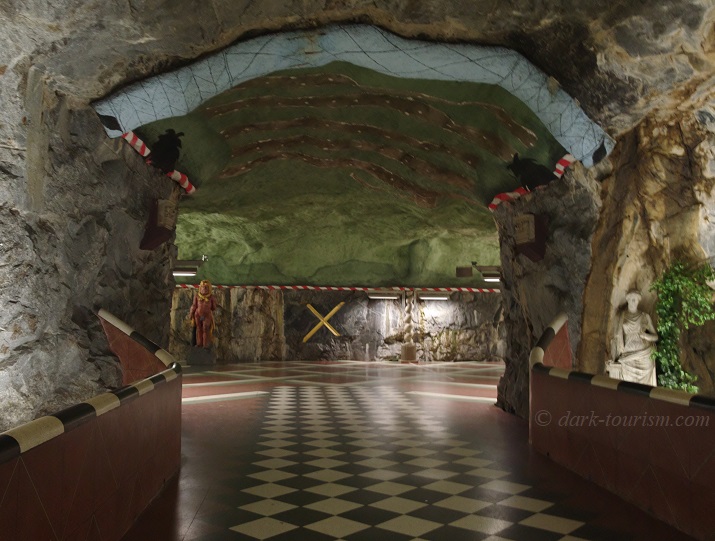
Here I found some details that can be seen as somewhat dark, like the radiation warning symbols and what appears to be the depiction of a volcanic eruption in the form of a lava fountain (why all this I have no idea):

Some devoted republicans may also see something dark in the fact that Sweden still has a monarchy. In fact, the Royal Palace, with its uniformed guards and old cannons in front, is rather a mainstream tourist attraction:
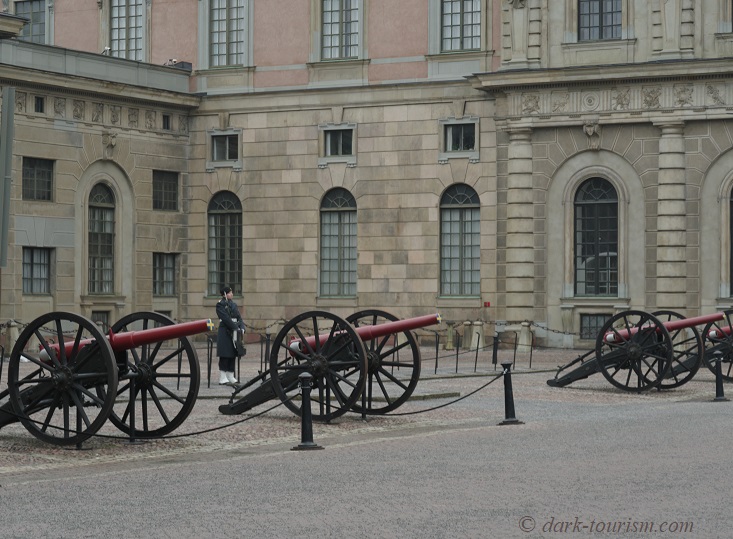
The prime mainstream attraction of Stockholm, though, remains Gamla Stan (the Old Town), which is indeed incredibly touristy these days – it always baffles me how so many souvenir shops selling the same sort of tack can all profitably coexist in such places. It’s hard to deny, though, that the colourful, quaint old buildings in this oldest part of Stockholm are quite picturesque:
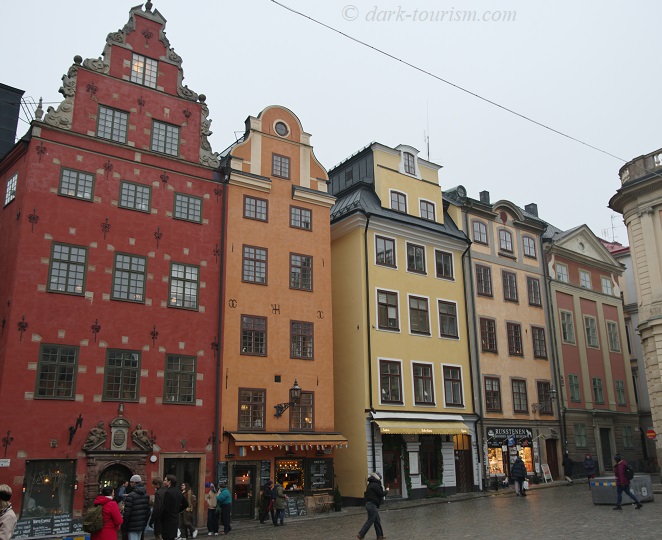
Wandering the streets of Gamla Stan I also happened upon this spooky advert for “Stockholm Ghost Walks”:
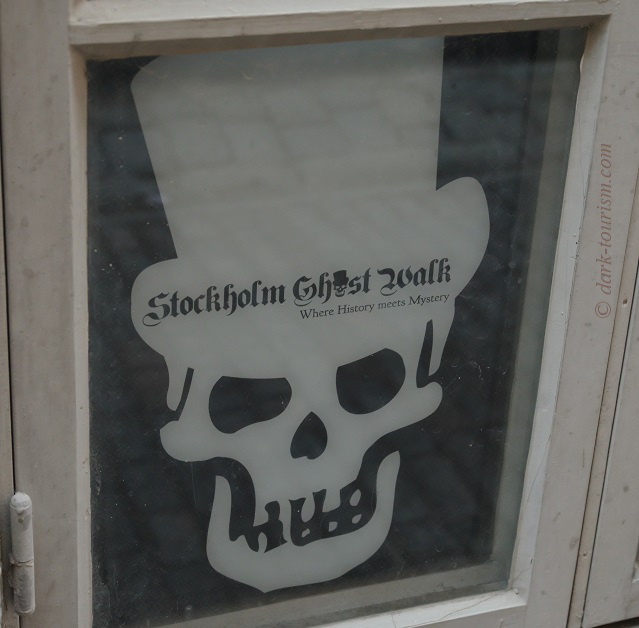
Such walking tours have become a standard offering in many cities these days. Some would argue they could be seen as part of dark tourism too. However, since I do not personally believe in ghosts or anything supernatural, my website excludes all “paranormal tourism” (as explained here), and I would never really want to take part in such ghost walks. I can imagine, though, that some of the narrow alleyways in the Old Town may be conducive to such activities …
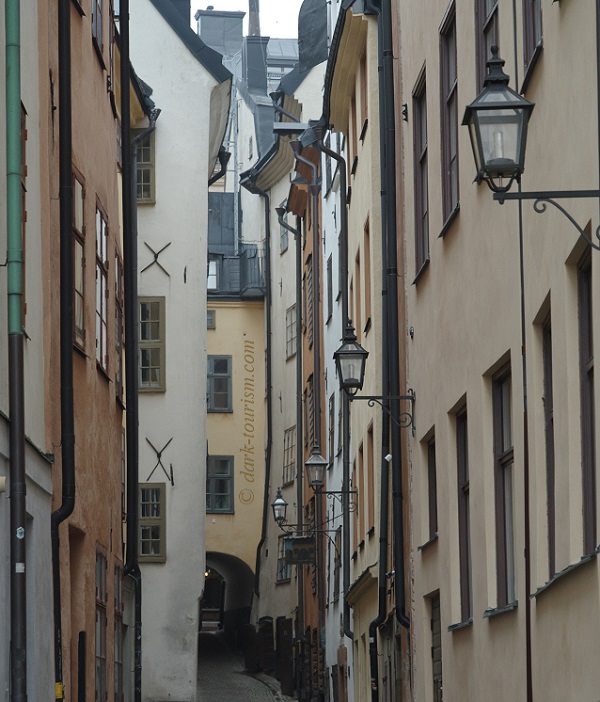
But with this I shall come to a close. It was great to be back in Stockholm, albeit only briefly, and I can well imagine that it wasn’t my last visit to that city. There’d be more in terms of DT too – not only the Jewish Museum mentioned above, there’s also a former prison on the island of Långholmen that’s been converted into a hostel/hotel and which also features a prison museum. A worthwhile dark attraction would also be the former R1 underground nuclear reactor hall at the Royal Institute of Technology in the north of Stockholm. However, this site is these days usually accessible to the public only during special events (like the “Stockholm Open House” festival), so timing it right would be a challenge …
Anyway, so much for this post – I hope you’ve enjoyed reading this little report of my DT-focused day in Sweden’s wonderful capital city.

